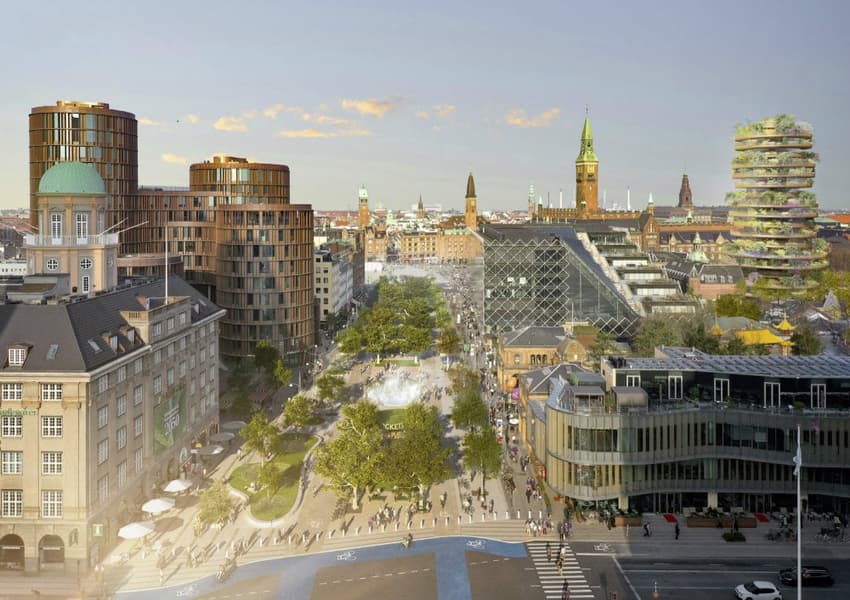How Copenhagen could transform one of its busiest roads into a park

Tivoli, the 175-year-old amusement park which is one of Copenhagen’s most iconic tourist attractions, on Monday presented two new projects which could transform the centre of the Danish capital.
Along with city planners Gehl, Tivoli presented on Monday a proposed 10,400 square-metre “recreational space” with only pedestrian and cyclist access in front of Tivoli and adjoining Copenhagen’s City Hall Square (Rådhuspladsen).
That would mean closing the busy Vesterbrogade to traffic between the central roads H.C. Andersens Boulevard and Bernstorffsgade, near to City Hall Square and the Central Station.
Trees and grass would then be planted as part of a new park and recreational area which would replace the current heavy traffic in front of the entrance to Tivoli.
“Only through projects such as this can Tivoli stay relevant for future visitors. It has been proven time and time again, that depending on Tivoli’s historic charm is not enough. Change is in Tivoli’s DNA, it is our heritage, and Tivoli has always hired the best architects to make sure that new additions will stand the test of time, because we are building for the future,” Tivoli CEO Lars Liebst said in a press statement.
Following Monday’s presentation, the next step for Tivoli and Gehl is to make final the proposals for the project and submit them to Copenhagen Municipality. There will also be a period for public hearings.
“I never say 'no' to more trees in (Copenhagen),” Lord Mayor Frank Jensen told Ritzau on Monday.
“The first step is to look more closely at traffic and put together an overall plan for the whole area, so we can ensure people can still get to and from the centre of the city and that there won’t be extra traffic in the area,” Jensen added.
“I will be at the forefront of this together with the city planning municipal committee leader (Karina Vestergård Madsen),” the lord mayor said.
A plan for financing the project must also be agreed before any start date can be considered.
In addition to the new park, Tivoli also wants to build a new 70-metre tall, 18-storey hotel. The new hotel has been designed by lead architecture firm Bjarke Ingels Group.
That project must also be approved by the municipality.
Comments
See Also
Along with city planners Gehl, Tivoli presented on Monday a proposed 10,400 square-metre “recreational space” with only pedestrian and cyclist access in front of Tivoli and adjoining Copenhagen’s City Hall Square (Rådhuspladsen).
That would mean closing the busy Vesterbrogade to traffic between the central roads H.C. Andersens Boulevard and Bernstorffsgade, near to City Hall Square and the Central Station.
Trees and grass would then be planted as part of a new park and recreational area which would replace the current heavy traffic in front of the entrance to Tivoli.
“Only through projects such as this can Tivoli stay relevant for future visitors. It has been proven time and time again, that depending on Tivoli’s historic charm is not enough. Change is in Tivoli’s DNA, it is our heritage, and Tivoli has always hired the best architects to make sure that new additions will stand the test of time, because we are building for the future,” Tivoli CEO Lars Liebst said in a press statement.
Following Monday’s presentation, the next step for Tivoli and Gehl is to make final the proposals for the project and submit them to Copenhagen Municipality. There will also be a period for public hearings.
“I never say 'no' to more trees in (Copenhagen),” Lord Mayor Frank Jensen told Ritzau on Monday.
“The first step is to look more closely at traffic and put together an overall plan for the whole area, so we can ensure people can still get to and from the centre of the city and that there won’t be extra traffic in the area,” Jensen added.
“I will be at the forefront of this together with the city planning municipal committee leader (Karina Vestergård Madsen),” the lord mayor said.
A plan for financing the project must also be agreed before any start date can be considered.
In addition to the new park, Tivoli also wants to build a new 70-metre tall, 18-storey hotel. The new hotel has been designed by lead architecture firm Bjarke Ingels Group.
That project must also be approved by the municipality.
Join the conversation in our comments section below. Share your own views and experience and if you have a question or suggestion for our journalists then email us at [email protected].
Please keep comments civil, constructive and on topic – and make sure to read our terms of use before getting involved.
Please log in here to leave a comment.